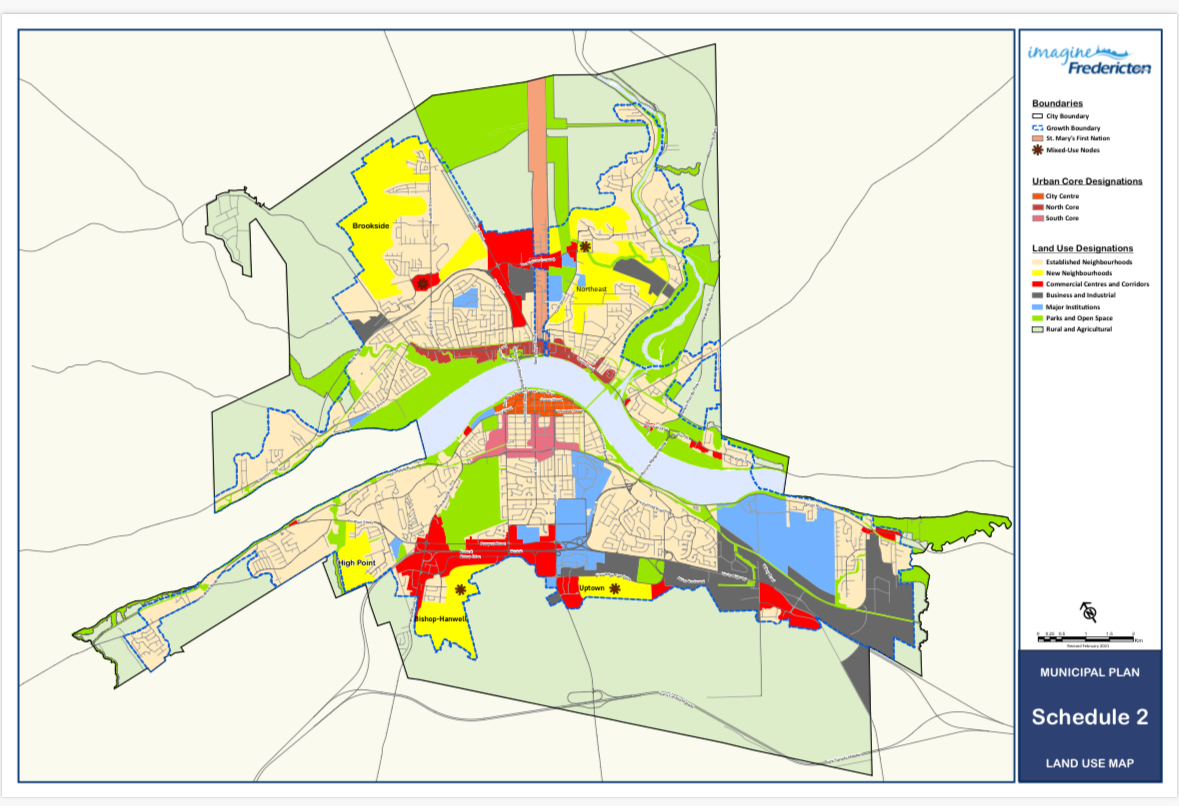Each morning, Frederictonians and inhabitants of nearby municipalities load up their cars and head in – or out – of town for work or errands.
Sunrise is spent in a long line of idling cars waiting to get on the Princess Margaret or Westmorland Bridge, afternoons in drive-thru pileups and evenings in the same morning lineups. On average, a person spends 59 minutes commuting to and from work per day.
It does not have to be this way — and it shouldn’t.
Mixed-use or compact nodes are planning terminologies akin to the concept of “15-minute cities,” seen throughout Europe. This concept originates from Franco-Colombian academic and researcher Carlos Moreno. This zoning practice reduces car dependency, encourages active transportation and keeps work, recreation and habitation all within an easily commutable vicinity.
The goal: that work, leisure and residence be all within a 15-minute walk or bike ride away. Although small, Fredericton lacks these communities and seems to be actively supporting the expansion of car-centric infrastructure. Fredericton’s municipal plan’s Land Use Map seems to categorize and separate, further restricting the feasibility of active transportation.

Their employment of the term “mixed-use node” is arguably pitiable since their supposed mixed-use nodes (right off Two Nations towards Cliffe, Knowledge Park Drive, off Brookside Drive and up near Hanwell-Bishop) are not compact enough to be considered adequate mixed-use nodes that support safe, active transportation and mobility.
Consider the heavily commercialized Two Nations Crossing Street on Fredericton’s Northside. It is now the home to seven single-floor strip malls with expansive car-centric parking lots and a serious lack of accessibility for those inclined to active transportation.
Just a street away, on Cliffe, there has been a huge multi-unit residential boom over the last couple of years. However, even the apartments closest to the intersection of Cliffe and Two Nations Crossing are a thirty-minute walk to the nearest grocery store.
Don’t want to walk on the sidewalk with all your bags? Good luck taking a bike, considering the Fredericton trail system randomly ends before reaching the heart of the commercial area.
Two Nations is not alone; on streets like Prospect and Main, where growth seems boundless, accessibility remains all the while deeply car-reliant.
To reduce our reliance on vehicles and lower our energy demand, we need to look towards building a denser city — utilizing and maximizing the spaces we already have.
With better planning, we could reduce the size of “new neighbourhoods” on the city’s Land Use Map and put that energy into upgrading the efficiency of current infrastructure.
All of these strip malls on Two Nations Crossing take a toll on the environment, but what if we built apartments or offices above strip malls to lower our land footprint?
Picture this: you finish a day at the office and walk five minutes down the street to the local grocer to pick up some ingredients for a picnic. Heading out of the store, you walk a couple minutes further to pick up your kids from school (no car lineup needed).
Since the courtyard in front of the kid’s school is a park (equipped with many amenities, bike trails, greenery, picnic tables and outdoor cafes) you settle down for a bite to eat and let the kids play with the neighbour’s children.
When the time comes, a swift walk down a scenic and lively street brings you to your home. This pedestrian-only walkway means that the stress of walking on sidewalks right off traffic with young kids is gone and the commute movement and time at the park has tuckered them out for a night of sound sleep.
Throughout this day, you’ve moved your body, smiled and connected with other people around you and you’ve effectively utilized a mixed-use node since you had all you needed within a walk away. There is a reason why so many of us flock to countries like France, Italy, or the Netherlands each year to embrace their lively streets and healthy lifestyles, it does us and the planet good.
Why can’t we start attempting the same here?
Separating work and life does not need to be so literal. If we want to meet climate targets, we need to embrace mixed-use nodes.
This zoning alternative will allow for more accessible, healthy and intermingling communities based in the built environment.
Nevertheless, I do not wish to badger this wonderful town. Indeed, Fredericton’s wonderful downtown holds promise and should inspire us when zoning future city growth as it is a near perfect mix of work, leisure, housing and entertainment that holds immense potential for active transportation.

